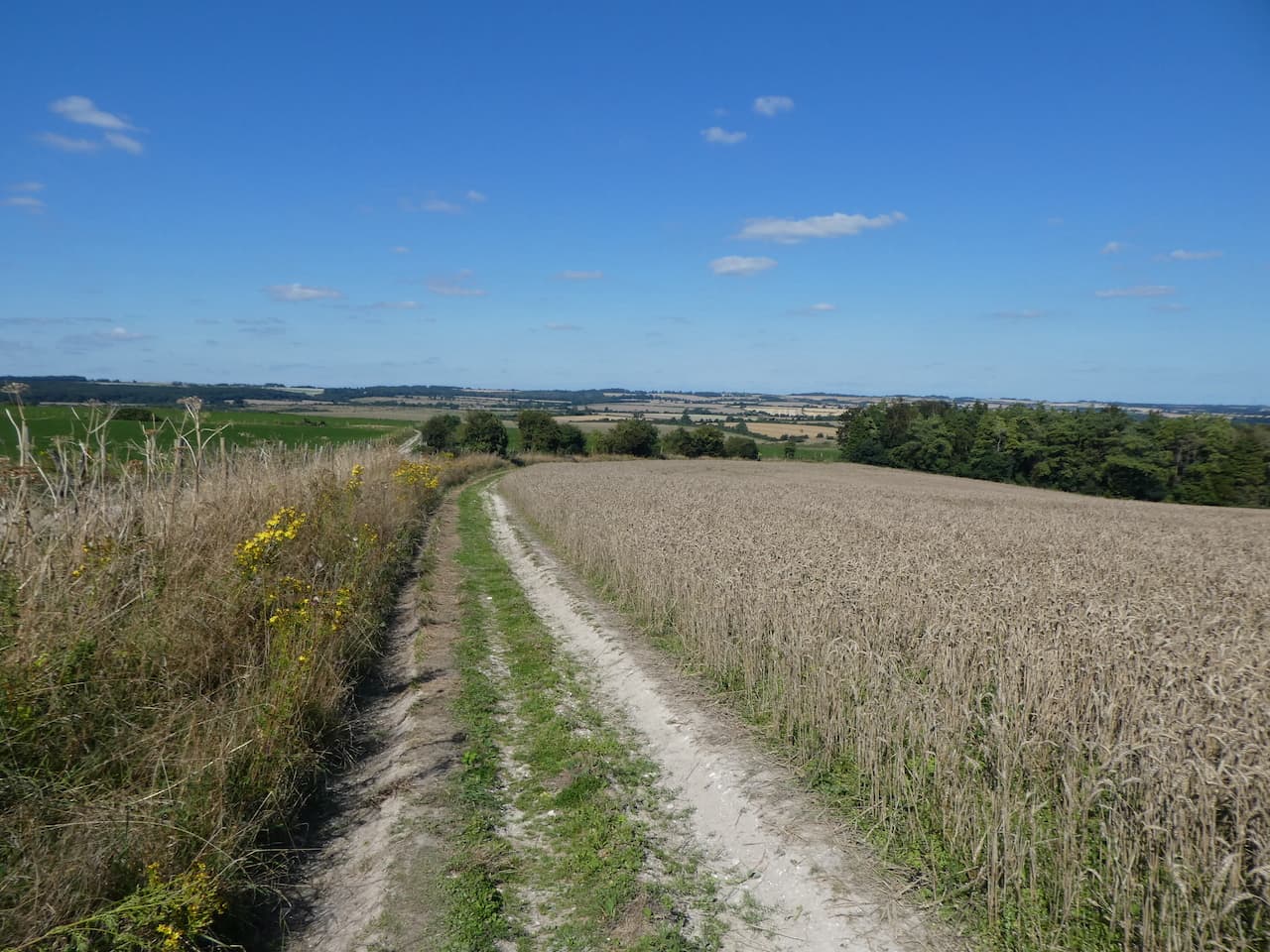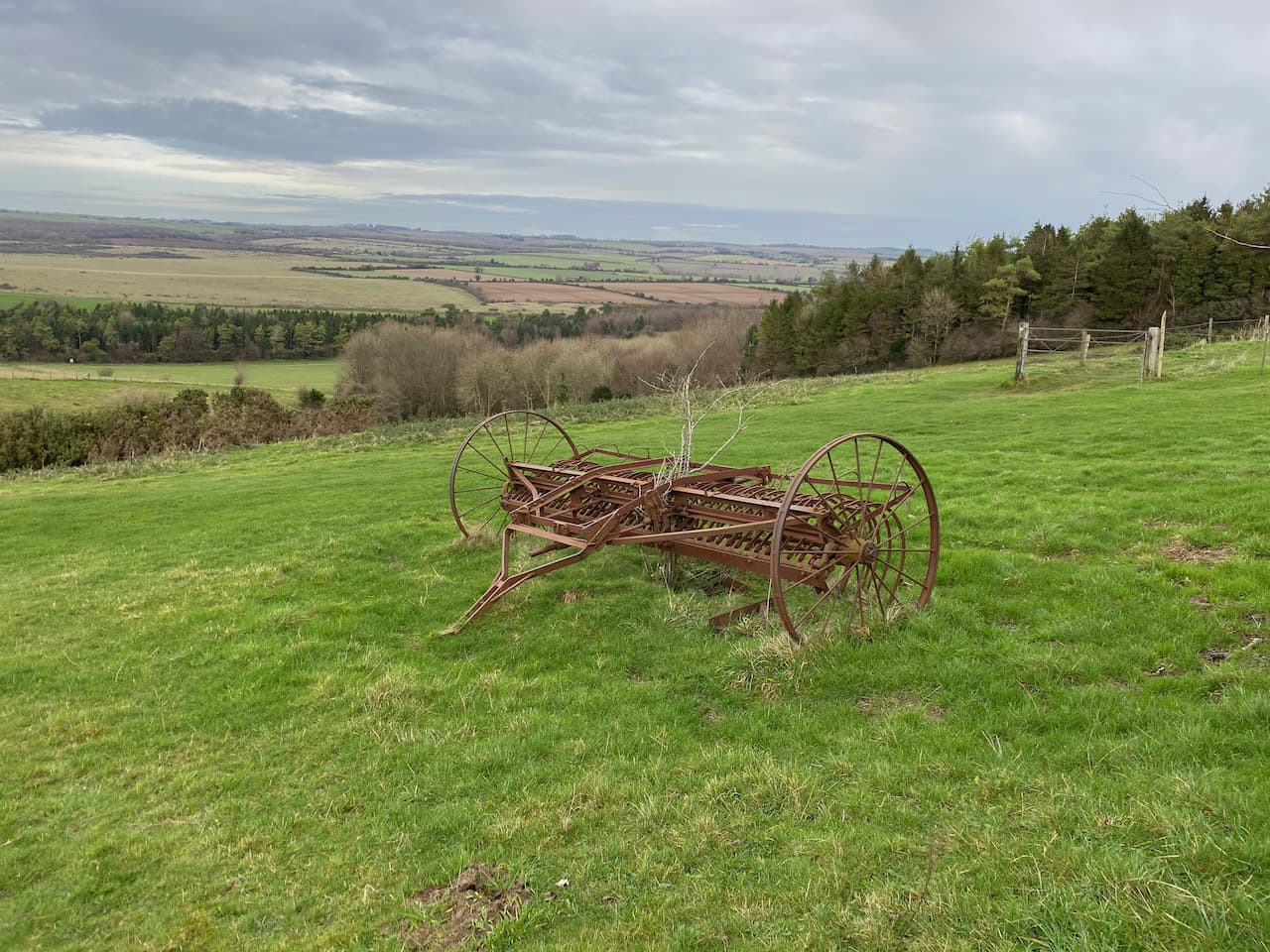Today I am walking in the Dorset countryside with my walking buddy Nigel from New Forest Navigation. Just over a year ago, whilst still avoiding contact with others, I did a cracking twenty mile walk from Martin Down that followed a section of the Ackling Dyke Roman Road and visited the Gussages. Today we are doing a similar, but shorter version of the route and along the way we will visit the location of a long lost Dorset village.
We start from the large Martin Down Nature Reserve car park besides the A354. Heading out from the southern end of the car park we pass a metal barrier beside information boards. Initially the path heads through shrub, but then opens out on to the vast expanse of the nature reserve, over 850 acres of protected land providing a haven for flora and fauna.

We follow the track towards the dominant rifle range butt in front of us. This area was used as a military rifle range up until the 1950’s and evidence is still strewn across this area of the downs. Before reaching the butt we take a path on the right heading across the Bokerley Dyke. This ditch is thought to have been built during the iron age and fortified in the 5th century. It runs for around 3.5 miles and is an impressive structure.
We pass through the dyke to reach the fence-line and enter a field taking a footpath on the right that continues along the edge of the field with the fence to our right. The path follows around the edge of the field and we are soon heading south with a hedge line to our right.

At a junction of paths we continue straight on to reach a gate besides a crossing of paths. Here we continue along a tree lined path still heading south towards Pentridge.
As the path reaches farm buildings it becomes a tarmac lane and we stay with this to walk into the village. Our route continues south through the village and passes Manor Farm to join a farm track.

At a junction of paths we turn right and follow a track that soon heads uphill along the edge of a field. The map shows the area we are walking through is the location of a Cursus, despite having walked here previously I had not paid much attention to this reference which is surprising because I am usually looking out for odd things on the map.
Like me Nigel spends time just looking at maps, there is a clue to this in his chosen line of work; teaching people to navigate. He explains a cursus is an elongated rectilinear Neolithic (c.3000-2400 BC) earthwork usually with a bank and external ditch, but occasionally by a line of closely-set pits. Their purpose is not known, which also tells us the Neolithic’s were too busy digging ditches and banks to record their purpose and they had little regard for future generations.

The path shows clearly through the crops as it crosses the next field. At a fork in the path we keep left to head towards the edge of Salisbury Plantation.

We ignore paths to the left and right as we follow the path along the edge of the woods to reach the course of the old Roman Road, the Ackling Dyke. Here we turn left to follow its route.

After crossing a stile there is an impressive array of tumuli in the next field.

Now we stay with the Roman Road as it gradually ascends to reach the B3081. After crossing the road we go through a gate and follow a path running besides the overgrown Roman Road.

The route descends steadily with fine views in front of us.

After crossing a farm track the route enters trees that form the edge of the Drive Plantation and continues on to reach a minor road. We cross the road and continue uphill through the edge of woodland. The Ackling Dyke covers 22 miles and connected the Roman settlements at Old Sarum on the edge of Salisbury and the Hillfort at Badbury Ring.

At a crossing of paths at Harley Gap we turn left and follow the Jubilee Trail along Harley Down.

This is the first time I have walked along this track. We soon get expansive views towards Penbury Knoll on Pentridge Hill. This prominent landmark will form part of our route but we still have a fair few miles walking before we get there.

At a junction of paths we turn right to leave the Jubilee Trail and within a few metres turn left to join a track (Coach Road) which heads towards All Hallows Farm.

After passing the farm we join a tarmac lane and continue straight on, soon reaching the neglected graveyard of All Hallows Church.

In the past this area was a thriving village known as All Hallows or Wimborne All Hallows and was far larger than nearby Wimborne St Giles. However, in 1672 Lord Shaftesbury whose seat was in Wimborne St Giles requested that the two parishes be combined by closing the living at All Hallows. He offered King Charles II a living of his choice in exchange for his agreement. Charles II agreed to this request and seventy years later the church was demolished and the stone used to build St Giles Church in Wimborne St Giles.
I don’t usually link to other people’s work in my blogs, but the Dorset Rambler has done some fascinating research into the village and some of the long deceased residents that now rest in this graveyard. It is well worth reading and can be accessed here.
From the graveyard we continue along the road heading towards Wimborne St Giles and soon pass the Bull Hotel. Sadly this pub is currently closed, apparently the owner is seeking tenants to run it, let’s hope they find someone and it is soon returned to its former glory.

A little further on we reach a road junction at Bull Bridge. This junction has one of those fingerposts which is unique to Dorset in that it displays its OS Grid Reference.

We now turn left and cross Bull Bridge and enter the heart of Wimborne St Giles. It is not a huge village and as well as being the seat of the Earl of Shaftesbury has a row of impressive Almshouses and the fine St Giles Church.

St Giles Church was constructed in 1732 on the site of an earlier medieval church and it incorporated masonry from the demolished All Hallows Church. Designed by the Bastard Brothers, who were architects from Blandford it stood until the early 1900’s when fire caused major damage. It was then rebuilt to the design of Sir Ninian Comper.
On my previous visits the church has been locked, but today it is open so I take a look. It is a very bright church with an elaborate font and fine carved screen.

Outside the church there are some old carvings in the stone work which appear to date back to 1764.

From the church we head back through the village passing the school and turning right at the village sign.

We now follow this lane running through the village past attractive cottages. At a road junction we turn right passing the Manor House and head north along a minor road. We have now joined the Hardy Way. This 220 mile route links parts of Wessex connected with Thomas Hardy.
At a track on the right we leave the minor road for a footpath along Ringwood Lane, still on the Hardy Way we keep with the trail way markers as it turns left to head north and then right going beside a field heading towards the B3081. Nearing Creech Hill House the path goes through a gap in the hedge and after crossing the road we continue heading east along a minor road towards Cranborne.
As the road bends to the right we stay with the Hardy Way and take a path on the left. This heads across fields to reach a common. In the field to our right is a large chair. This oak chair, created in 2006 was originally sited on Dartmoor, but apparently Dartmoor Park Authority issued an enforcement notice for it to be removed and it was relocated to the grounds of Cranborne Manor.

We follow the footpath across the common into the village. In the days of King Henry VIII Cranborne Chase was a Royal hunting ground and this was a major centre. Henry built a hunting lodge here.
We leave the village along Salisbury Street, at a fork in the road we take a tarmac lane signed posted “Bridleway to Pentridge”. This lane heads steadily uphill, passing houses to reach a gate across the track.

We pass besides the gate and continue along the bridleway. At a junction of paths at Jack’s Hedge Corner we stay with the bridleway.

Four hundred metres after Jack’s Hedge Corner we take a footpath on the right. This initially runs parallel to the track, but separated by a hedge.

We now follow this path as it steadily ascends Pentridge Hill. After passing through a band of trees we enter a pasture field with Shepherd’s Huts dotted about.

We cross a stile to join a footpath on Pentridge Hill and turn right towards Penbury Knoll. The views from here are stunning.

After going through a gate we pass Penbury Knoll and continue on a footpath along the top of Pentridge Down. Below us on the left is a medieval field system and further extensive views.

At a fork in the track we leave the Jubilee Trail and follow a grassy path that heads steadily downhill towards Whitey Top Farm. After crossing a stile we join a footpath heading north besides the edge of an arable field. We have once again joined the Jubilee Trail, this is an 88 mile path crossing Dorset from Forde Abbey near the Somerset border to the Bokerley Dyke.
We go through a gate and then continue along the edge of a copse to reach Martin Down at Bokerley Ditch. On the downs we turn left and walk besides the stunning Bokerley Ditch.

The path is easy to follow and we stay by the ditch until we reach the rifle range butt where we retrace our steps to the car park. Our walk has covered just over sixteen miles and has, as always in Nigel’s company, been a thoroughly enjoyable walk.
To follow my walk, you will need Ordnance Survey Explorer Map 118 – Shaftesbury & Cranborne
You can view this 16.5 mile walk on OS Maps and download the GPX File Here
25th August 2021
© Two Dogs and an Awning (2021)
All information on this site is provided free of charge and in good faith and no liability is accepted in respect of damage, loss or injury which might result from it. To the best of my knowledge the routes are entirely on public rights of way or within areas that are open for public access.
Walking can be hazardous and is done entirely at your own risk. It is your responsibility to check your route and navigate using a map and compass.


















































